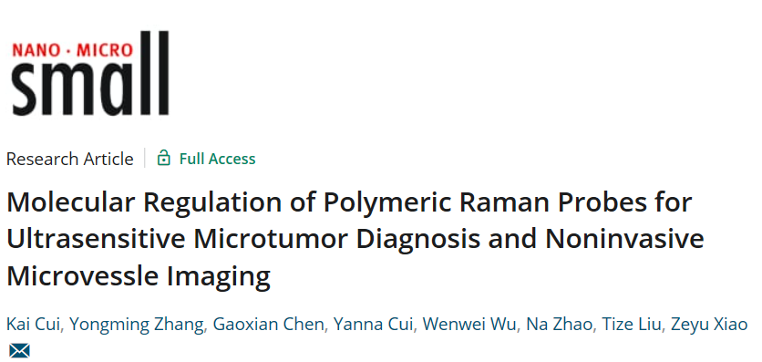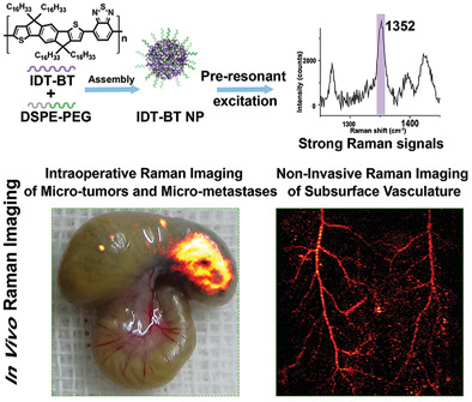
The article Molecular Regulation of Polymeric Raman Probes for Ultrasensitive Microtumor Diagnosis and Noninvasive Microvessle Imaging was published in Small by Professor Zeyu Xiao Lab of Basic Medical Sciences on 29 January 2022, developed a polymeric Raman probe for ultrasensitive biological imaging in vivo: poly (indacenodithiophene-benzothiadiazole) (IDT-BT).
Abstract
Raman imaging is a powerful tool for the diagnosis of cancers and visualization of various biological processes. Polymers possessing excellent biocompatibility are promising probes for Raman imaging. However, few polymers are reported to serve as Raman probes for in vivo imaging, mainly due to the intrinsic weak Raman signal intensity and fluorescence interference of these polymers. Herein, a poly (indacenodithiophene-benzothiadiazole) (IDT-BT) polymer is presented, which emits unprecedentedly strong Raman signals under the near-infrared wavelength (785 nm) excitation, thus functioning as a Raman probe for ultrasensitive in vivo Raman imaging. Further mechanistic studies unveil that the unique Raman feature of the IDT-BT polymer relies on molecularly regulating its absorbance edge adjacent to the desired excitation wavelength, thus avoiding fluorescence interference and simultaneously emitting strong Raman scattering under preresonant excitation. Taking advantage of this discipline, the IDT-BT polymeric probe successfully realizes intraoperative Raman imaging of micrometastasis as small as 0.3 mm × 0.3 mm, comparable to the most sensitive Raman probes currently reported. Impressively, the IDT-BT enables noninvasive microvascular imaging, which is not achieved using other Raman probes. This work opens a new avenue toward the development of polymeric Raman probes for in vivo Raman imaging.
Link: https://onlinelibrary.wiley.com/doi/10.1002/smll.202106925
About Lab
Laboratory of Visualized Drug Delivery
The group has been dedicated to develop visualized drug delivery systems with high sensitivity and high selectivity for disease diagnosis and therapy, by using interdisciplinary technologies and methods (e.g. chemistry, biology, pharmacology and molecular imaging). The specific research contents are as follows:
(1) Developing visualized drug delivery systems based on in-vivo optical imaging (such as Raman imaging) or nuclear medical imaging technologies, for intra-operative diagnosis and removal of residual micro-tumors, reversing targeted-drug resistance, medication guidance and treatment evaluation;
(2) Investigating oral drug delivery system for naked-eye visualization and treatment of colon diseases at the early stage;
(3) Designing DNA-modularied programmable bivalent drugs for precise receptor regulation.
Recently, we have published more than 40 research articles in the international academic journals (e.g. Chem Soc. Rev., Nature Comm. Angew. Chem., Nano Lett, ACS Nano, Adv Funct Mater., etc), and three Book Chapters. Among them, there has been 1 article cited more than 1000 times, 5 articles cited more than 200 times, 7 articles cited more than 100 times, and 3 articles selected as the highly cited papers by ESI. One visualized drug delivery system has begun clinical trial stage. In addition, we also have applied/authorized two international patents and one domestic patent.





